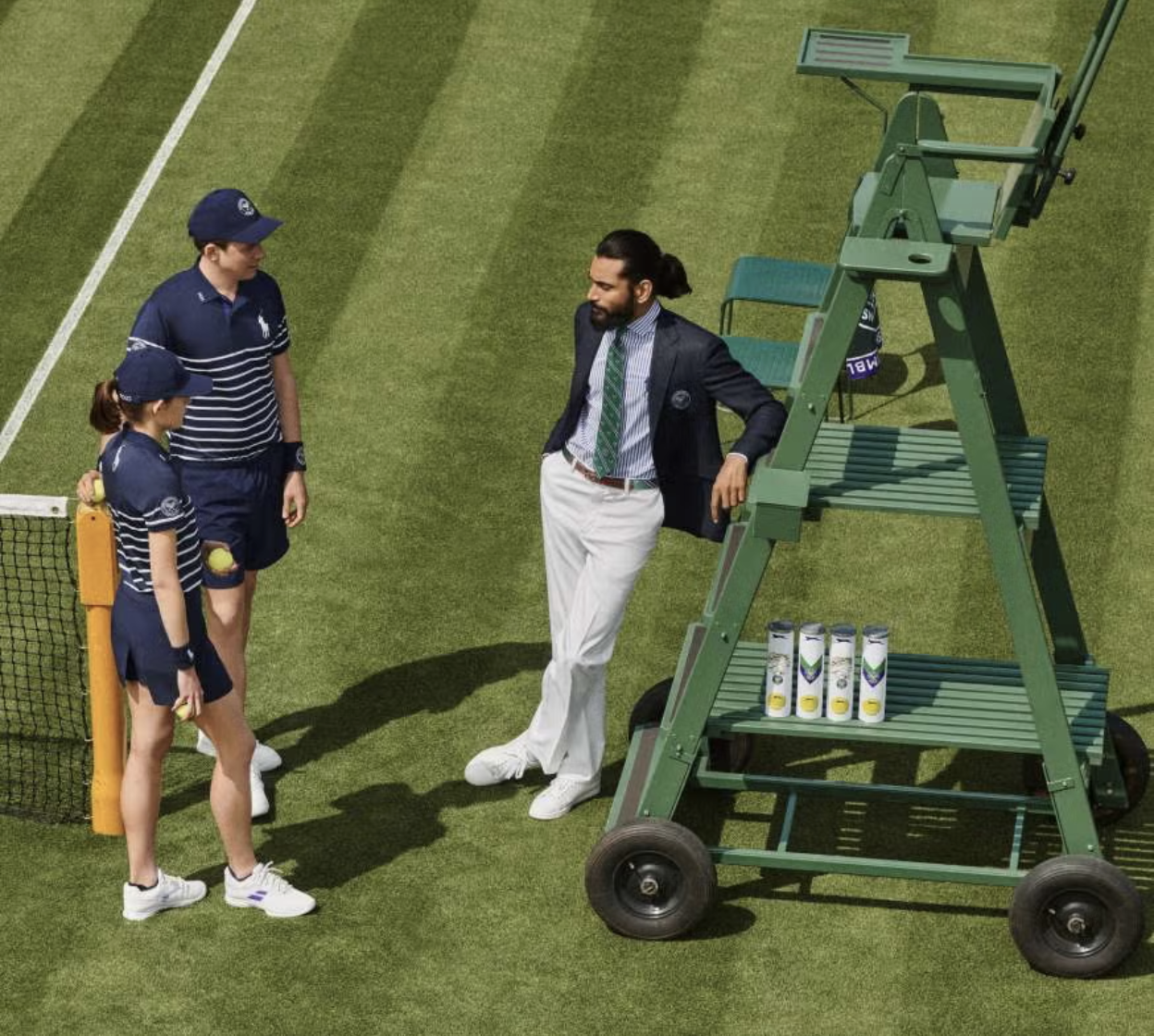White Lines and Quiet Luxury: Fashion, Class, and Performance at Wimbledon
As the Wimbledon Championships 2025 draw to a close, its cultural impact feels prominent. The Championships might be one of the most prestigious sporting events of the year, but its relevance in fashion is undeniable. With figures like Cate Blanchett, Hugh Grant, or David Beckham in attendance, Wimbledon has become a quintessential expression of British identity, where sports and fashion become equal. In the heart of South West London, this tournament projects class and luxury ideals through performance and personal style. Fashion has, for long, been dictating hierarchy, just as tennis itself has historically been a marker of socio-economic wealth. At the All English Lawn Tennis Club, both legacies combine and reinforce each other. Constrained by a strict dress-code, sporting brands have shifted the way they dress their players, making the audience follow, finding clever ways to subvert norms. Wimbledon leaves room for an interesting commentary to observe how this sport-fashion, and its evolution, both reinforces and subverts existing class hierarchies.
Federer in the Wimbledon Championships 2009. Credit: ArtPhotoLimited
On an (inappropriately) early Sunday morning, I put on my striped linen trousers and a white boat-neck blouse, ready for my first Wimbledon attendance. While no specific dress code is enforced on the crowd, British residents know the tournament has a distinct look. High necklines, sharp tailoring, striped polos… the court stands exude a Ralph Lauren-esque old-school spirit. Through and beyond clothing, the tennis grounds become a site of tradition and performance, for both players and viewers. Between champagne pops, Pimm’s, and strawberries with cream, smell and sound all merge towards a broader quiet luxury. To attend Wimbledon means to enter a carefully orchestrated world of tailoring and breezy linen dresses.
The British Championships distinguish themselves from other grand slams due to its uniquely strict all-white dress code. Not ivory, not off-white: pure white only. This tradition goes back to the Victorian era, where sweat was considered improper and white was the best colour at hiding it. The all-white legacy has been kept up by the tournament committee, with barely any amendments, making sure all players adhere to a very strict set of rules. The only recent shift in rules has been allowing women to wear black undershorts. Sportswear brands however, still find ways to subvert the strict code, to showcase their creative designs.
Tracy Austin, 1972 Steffi Graf, 1989 Serena Williams, 2015 Coco Gauff, 2025
When looking back at women’s tenniswear in the past 4 decades, a reflection of personal style and epoch is translated. In the 80s, a more classic, dainty and flattering attire was sported by the likes of Tracy Austin. Whereas in the 90s, comfort, oversize and lazy fashion was it. In the 2000s and 2010s, function and style started to combine with high-tech sportswear and simple lines. This year, sports brands continue to push the boundaries with material technologies, while finding ways to reflect the brand and player’s signature style. Coco Gauff’s look this year was the epitome. Wearing a flowery embroidered corset-like top and a skirt ensemble by New Balance, Gauff embodied femininity and chicness while being dress-compliant. While her time at Wimbledon might have been short-lived this year, her look will remain remembered.
As silhouettes and trends have evolved, the all-white attire has remained, making it the most stylish tournament for some. With this showcasing of style through performance emerges a broader question: is dress code a tool of control and discipline as opposed to tradition and style?
Sabalenka’s Emerald Jewellery Credit: The Guardian
In tennis, fashion becomes a performance. Walk-on looks have become as curated as match-day strategy, with players stepping onto court not just as athletes but as stylised personas. The lines between sport, celebrity, and brand representation are increasingly blurred, and Wimbledon’s grass court is as much a runway as it is a battleground. This season saw players push subtle boundaries. Aryna Sabalenka, known for her powerful baseline game, accessorised her on-court whites with emerald jewellery—a quiet assertion of individual glamour within a tightly regulated space.
Musetti’s Bottega Veneta jacket Credit: Vogue Alcaraz’s Nike Cardigan Credit: Forbes
But it’s off-court looks where players now make their boldest statements. Italy’s Lorenzo Musetti, arrived draped in a crisp Bottega Veneta jacket, while Carlos Alcaraz brought a cardigan sweater to his Nike kit, echoing Federer’s legacy, embedded in Wimbledon’s visual tradition.
The rise of social media has also had a non-negligeable impact on players’ fashion, making TikTok a key platform for sports and fashion to intersect. Morgan Riddle’s TikToks, partner of American player Taylor Fritz, have elevated her into a cultural figure in her own right: style blogger and unofficial ambassador for Gen Z’s reimagining of tennis culture. Through her lens, Wimbledon becomes not just a sporting tradition, but a lifestyle, aspirational yet accessible, curated in real time for digital audiences
Umpire and ballkids Ralph Lauren Uniform 2025 Credit: Ralph Lauren
Ralph Lauren, Wimbledon’s official outfitter since 2006, plays a central role in setting the quiet luxury tone. From the sharp navy blazer uniforms of the umpires to the tailored fits of the ballkids, the brand wraps the tournament in a fantasy of transatlantic heritage. It’s a world of Wimbledon whites tinged with Polo preppy elegance—an aesthetic exported and consumed globally as an aspirational lifestyle, not just sportswear.
Monica Barbaro and Andrew Garfield Credit: Getty Images
Olivia Dean Credit: Getty Images
Olivia Rodrigo and Louis Partridge Credit: Vogue
Spectators lean into the fantasy with visible intention. Brands like Reformation, The Row and Ralph Lauren are spotted courtside—quiet luxury labels whose neutral palettes and whisper-soft silhouettes exude affluence without overt display. Mixes of creamy whites, sharp-tailoring, gingham patterns, wide-legged structured trousers, celebrities in the royal box make sure to bring their own A-game at the Championships. At Wimbledon, to be stylish is to appear effortless. Anything too obvious breaks the spell.
This is where Wimbledon reveals itself not merely as a tournament, but as a mechanism of soft power. To dress for Wimbledon is to participate in a semiotic game—one that rewards fluency in the grammar of Britishness, wealth, and restraint. Here, taste is wielded like a tennis racquet: strategically, defensively, and often unconsciously
Morgan Riddle for Wimbledon’s social media Credit: Wimbledon
Yet performance doesn’t always mean conformity. Within the rigid structures of Wimbledon’s aesthetic tradition, players and brands continue to carve out space for individuality, flair, and even resistance. Whether through a strategically placed earring, a sponsored capsule collection, or a TikTok from the players’ box, new scripts are being written. Wimbledon remains one of the most tradition-bound events in global sport. But in the age of style influencers, luxury-sportswear crossovers, and performative branding, its surface is increasingly unstable. Beneath the white linen and strawberries, taste is taught, class is performed, and identity is always in play.
Because at Wimbledon, tennis isn’t just played. It is worn. And even when the match ends, the performance continues.












